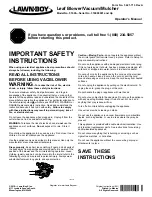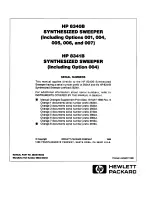
11
05
Installation
Manual 2008 Rev A p/n 2008
WARNING
!
Upon completion of the installation, and
before applying power, rotate the drive
shaft by hand. It must move freely. If it
does not, look for uneven mounting, piping
strain, excessive belt tension or coupling
misalignment or any other cause of binding.
If blower is removed and still does not move
freely, check inside the blower housing for
foreign material.
Remove the protective covers from the shaft
and inspect for damage.
Carefully check to ensure that no transit damage
has been sustained. If damage has occurred from
shipment, file a claim with the carrier immediately.
Preserve the shipping container for inspection by
the carrier.
In the event that your unit sustains damage
while being shipped to your facility, do not
return it to the factory without first obtaining
shipping instructions from us.
Do not remove protective covers and plugs until
the connections are complete. Mount the blower on
a flat, level surface. Use a baseplate that is rigid,
solidly supported, and structurally sound. Shim
under the legs where necessary so that each leg of
the blower supports an equal share of the blower
weight. This is necessary to prevent twisting of
the blower. Make sure the feet rest evenly on the
mounting surface before fastening down. Twisting
or cramping the blower during mounting will
cause rotor contact and binding during operation,
resulting in a condition called “soft foot.”
See
Soft Foot on page 13
for further details and
preventative measures.
A blower that is factory-mounted on a base should
not require such adjustments. However, since
the assembly can become twisted in shipping or
installation, check for soft foot after installing the
base. Shims may be needed for alignment. Loosen
the foot hold-down screws to check foot contact
with the mounting surface. Mount the base on a
solid foundation or heavy flooring, using shims
as necessary at bolting points to prevent warping
the assembly.
See Foundation on page 12
for
more information.
Transmission of small operating vibrations to a
support structure may be objectionable in some
applications. Use of vibration isolators or vibration-
absorbing materials can be effective in overcoming
this transmission. To avoid causing distortion, apply
the treatment under the common motor/blower
base or mounting plate rather than directly under
the feet alone.
Make sure piping is accurately squared with the
blower and supported independently. Stress
imparted from incorrectly aligned piping or
mounting will create problems with bearing and
seal life, possibly leading to premature internal
contact. The blower should sit stress free and
evenly on its supporting surface. Take care
to evenly tighten the mounting bolts to avoid
imparting undue stress into the blower. Stress
can be checked in a free state with feeler stock or
verified on a previously installed blower with the
aid of a dial indicator. Spring or gap should be less
than 0.002 in. (0.05 mm).
Use only clean, new pipe and make certain it is
free of scale, cuttings, weld beads, dirt, or any
other foreign material. To guard against damage
to the blower, make sure that an inlet filter is used.
Clean the filter of collected debris after 3 hours of
operation and periodically thereafter.
See Piping
Connections on page 18
for additional details.
Figure 5-1
shows a typical complete installation
of the blower and accessories. Note the absence
of throttle or shut-off valves in both discharge and
intake piping. If it is possible for airflow to be cut off
in either line, add a pressure and/or vacuum relief
valve. In some installations, it may be desirable to
use only an inlet silencer-cleaner supported directly
from the blower connection. Keep the weight of
accessories and piping to a minimum to prevent
blower casing distortion. If the weight exceeds
10% of blower weight, support the components
independently of the blower and connect them with a
flexible hose or connectors. The approximate weight
of the blower is listed in
Table 4-1 on page 8
.
Summary of Contents for PD Plus 9000 Series
Page 65: ......
















































